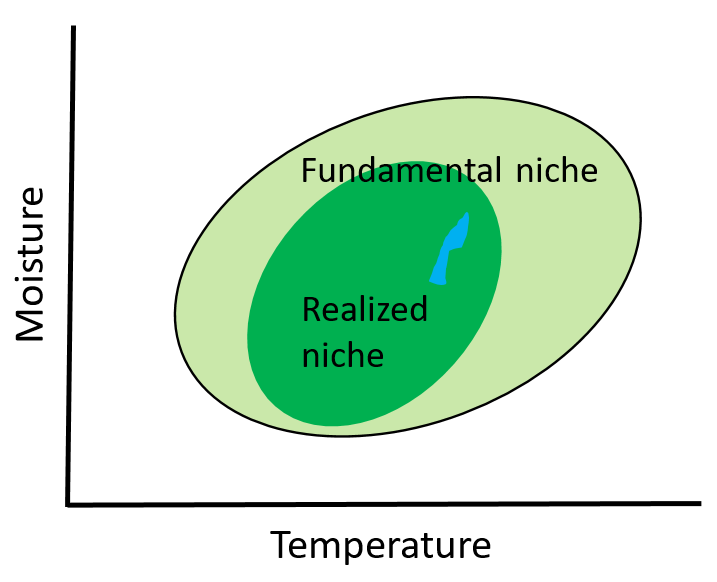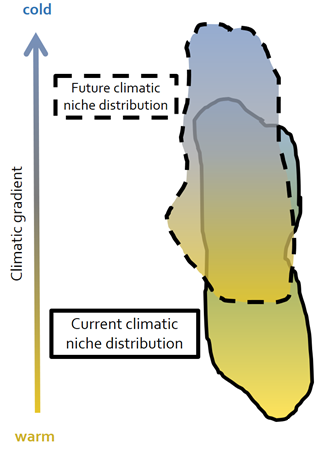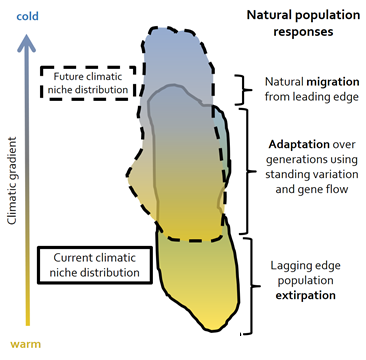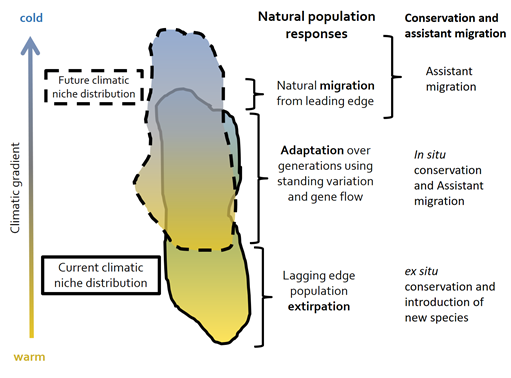8 Topic 5.1. Model Interpretation and Applications
Contents
1 Model interpretation
1.1 Climatic niche models vs. species distribution models
1.2 fundamental niche vs. realized niche
2 Model applications
2.1 Predictions for the current period
2.2. Future projections
2.3 Understanding species responses to climate change
2.4. Providing a basis for resources management
1. Model interpretation
A niche-based model can be interpreted as a species distribution model (SDM), an ecological niche model, or a climatic niche model. If it is considered as a niche model, it can also be interpreted as a fundamental niche model or a realized niche model. Different interpretations can lead to different expectations and provide different implications for applications in mitigation and adaptation to climate change. Thus, how to interpret a model prediction is critical for model applications.
1.1 Climatic niche models vs. species distribution models
If a climatic niche model is considered as a SDM, and the model predictions for a future period likely face criticisms for not considering the following factors:
- The rate of migration of the species;
- Interactions with other species at new sites;
- Impacts of pests and diseases
- Interactions with micros in the soil
- Soil conditions;
- …
Those criticisms are all correct as they all affect the species distribution. Thus, a niche based-model cannot predict the actual species distribution. What the model can predict is the spatial distribution of suitable climate conditions for the species. So, strictly speaking, a climatic niche model should not be called a SDM although it is often called so.

Figure 1. Criticisms are valid if a climatic niche model is called a species distribution model (SDM). Image by Tongli Wang under CC BY 4.0.
You may wonder, the species occurrence data, which are used to build the climate niche model, reflects the factors listed above, why the future predictions of the model do not consider these factors? It is true that these factors are considered in predictions for the current period, in which the predicted geographic areas are local or overlapping with the occurrence data points (Figure 2). For future or historical periods, predicted areas are, at least partially, in new locations, where the above-listed factors can be different. However, as these factors are also affected by climate, the effect of these factors may fade out in the long run.

Figure 2. Model predictions for the current (a) and a future (b) period. Black diamonds in (a) are locations of presence data points. Image by Tongli Wang under CC BY 4.0.
Predicted distribution of the climatic niche of a species can serve as a baseline of the potential distribution of the species. Predictions of other factors, such as soil conditions, can be overlaid onto the baseline to refine the potential distribution of a species.
1.2 fundamental niche vs. realized niche
If a climatic niche model for a species is built based on presence and absence data with climate variables for a species, we consider the model predictions represent the realized climatic niche (RCN) of the species (Figure 3). The RCN reflects the suitable climatic conditions supporting the current species distribution in the presence of interspecific competitions and other factors listed in Figure 1. If an area is predicted to be within the RCN, it indicates that this area has the potential to support the occurrence of the species if the species face the same interspecific competitions and the same other factors. Those factors may not be available in the area and may have a negative or positive effect on the species. For example, if suitable soil conditions are not available there (e.g., a lake), the species cannot occur for sure. On the other hand, if competing species are absent, such in plantations, the speices may go well beyond its RCN. Again, as climate drives almost all other factors listed in Figure 1 in long run, those factors would eventually come in to play. The majority of climatic niche models and so-called SDMs reported in the literature are in this category. Predictions of RCN for future periods indicate the potential occurrence of a species through natural processes. They can also conservatively guide assisted migration of a species through plantations.

Figure 3. Illustration of fundamental niche and realized niche in two dimensions. Image by Tongli Wang under CC BY 4.0.
For a model that is built based on a comprehensive provenance test, such a universal response function (URF), we also consider it as a CNM, but it predicts fundamental climatic niche (FCN) as illustrated in Figure 3. A CNF represents the ranges of physical conditions within which a species can survive, grow, and reproduce without the presence of interactions with other organisms. Predictions of FCN for future periods can provide information to guide assisted migration of a species through plantations, which do not involve interspecific competitions.
After a climatic niche model is built for a species, it can be used to predict the spatial distribution of the climatic niche for historical, the current and future periods, and even for paleo periods, depends on the climatic variables to be fed to the model. Predictions for different periods have different implications for forest resources management, including mitigation and adaptation to climate change.
As the future climate variables from the General Circulation Models (GCMs) are projected with uncertainty, the terms “projected” and “projections” are used to describe the output of climate niche models for future periods. On the other hand, “predicted” and “predictions” are used to refer to the output of climatic niche models for historical or the current period.
2.1 Predictions for the current period
Each tree species is adapted to a specific range of climate conditions – a climatic niche. To understand the climate niche of a species is essential for the resources management of the species, especially for formulating seed transfer guidelines and assisted migration under a rapidly changing climate. Predictions of a climatic niche model for the current period can be used to map the spatial distribution of the climatic niche under the current climate conditions (Figure 4) and to define the climatic niche in terms of major contributing climate variables. However, for most of the forest tree species, such information is still lacking although we know their geographic distributions. Thus, a climatic niche model and its predictions for the current period are important.

Figure 4. Illustration of geographic distributions of the climatic niche of a species under the current climate conditions. Image by Tongli Wang under CC BY 4.0.
2.2. Future projections
After predictions are mapped for the current period, projections for a future period can be overlayed on the top of the current one, which allows comparing their changes over the current period (Figure 5). This overlay can provide a framework to: 1) assess the potential shift in the spatial distribution of a climatic niche from the current to a future period; 2) understand the responses of the species to climate change and for developing adaptive management strategies; and 3) develop forest adaptive strategies under a changing climate.
For a species in the north atmosphere, the projected distribution of its climatic niche often shows a northward shift, as illustrated in Figure 5. It also always shifts upward. Changes in geographic coordinates, altitude, and areas from the current to a future period can be estimated. Of course, for future projections, it often needs to project for different future periods with various climate change scenarios.

Figure 5. Illustration of geographic distributions of the climatic niche of a species under the current (solid outlines) and a future (dashed outlines) climate conditions. Image by Tongli Wang under CC BY 4.0.
2.3 Understanding species responses to climate change
Trees or populations in different parts of a species distribution may respond differently to climate change. The overlay of the future distribution of a climatic niche over the current distribution, as shown in Figure 5, can help us to understand the responses of a species to climate change.
Trees in the leading edge of the distribution are likely to migrate to areas where are projected to be climatically suitable for the species under a future climate (Figure 6). However, the migration of the species into the newly available habitat will likely be lagging behind the shift in the spatial distribution of the climatic niche. This is because the rate of climate change is predicted to be far greater than the rate of species migration, which is affected by seed dispersal, physical barrier, soil, and other factors.
Trees in the lagging edge (or trailing edge) of the distribution are projected to be suffering from unfavorable climatic conditions as they would be outside of its climatic niche (Figure 6). A climatic mismatch will be a major challenge for these trees. Depending on the level of the mismatch, some populations in the lagging area may eventually be extirpated.
Trees in the areas, where the future distribution of the climatic niche overlaps over the current one (Figure 6), remain within their climatic niche in the future climate at the species level. Trees in these areas are less vulnerable to climate change than that in the lagging edge. However, they will no longer be in their optimal conditions at the population level, as illustrated in Figure 9 in 4.1, and will be under selection pressure. Within- and among-population variation, as well as gene flow, may facilitate adaptation to a changing climate.

Figure 6. Potential responses of a species to climate change in different regions based on the overlapping status between the current and a future distribution of the climatic niche. Image by Tongli Wang under CC BY 4.0.
2.4. Providing a basis for resources management
A good understanding of species response to climate change based on the framework of climatic niche distributions (Figure 6) provides a scientific basis for forest resource managers to develop adaptive management strategies to mitigate the impact of climate change. Such strategies should reflect the characteristics of the different sections of the species distribution.
For the areas in the leading edge of the distribution, assisted migration is suggested to be a priority (Figure 7). As mentioned above, the rate of climate change is far greater than the rate of the natural migration of almost all tree species. When areas become suitable for a species, particularly for a favorable species, assisted migration may become necessary or beneficial to take the use of these areas.
For areas in the lagging edge of the distribution, ex situ conservation is considered important (Figure 7). Genetic variation existing in the populations should be conserved through seed collections in cold storage. Seed transfer for plantation in the overlapping areas is another way to conserve the genetic resources under a changing climate. Some silvicultural measures, such as thinning, may also be helpful for trees to mitigate the impact of climate change in these areas. Meanwhile, the introduction of new species should also be considered for better use of natural resources available in these areas. As trees in these areas are most vulnerable to climate change, monitoring of the stand dynamics might be necessary.
For the overlapping areas (Figure 7), in situ conservation is important to ensure that the species can adapt to a changing climate through evolution and local adaptation. As the trees are not in their optimal climatic conditions at the population level, their growth and productivity might be compromised, although survival may not be a concern. Thus, assisted migration at the population level, also referred to as assisted gene flow or seed transfer, may be necessary.

Figure 7. A screenshot of the file-open box to illustrate the selection of a raster input file. Image by Tongli Wang under CC BY 4.0.

By Tongli Wang, Climate Modelling and Forest Applications is licensed under Creative Commons <CC BY-NC-ND 4.0> License

